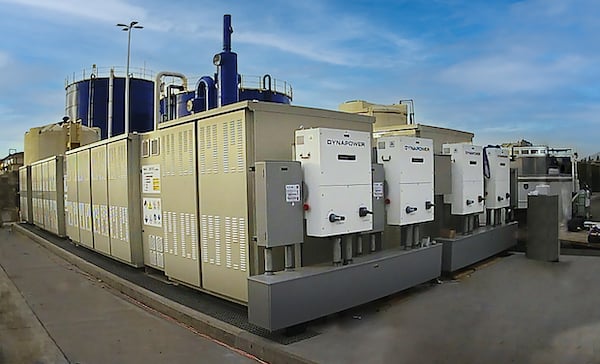
The First Nation community’s microgrid is designed to provide resilience during public safety power shutoffs (PSPS), during which California utilities essentially shut off distribution feeder lines to areas at risk of wildfires, to prevent equipment causing or exacerbating the deadly fires. It will also be available for use in emergency outage situations caused by other things.
Redflow CEO Tim Harris told Energy-Storage.news that additionally, the microgrid will help offset the Band’s use of power from the grid during peak demand periods.
Funding will come from the California Energy Commission (CEC) grant programme for long-duration energy storage (LDES), aiming to help a range of different LDES technologies to bridge the gap towards commercialisation through impactful real-world projects. The total pot for that programme is US$380 million, US$140 million of which is being allocated during the 2022-2023 fiscal year and the remainder the following year.
The zinc-bromine system will be one of the biggest zinc-based energy storage facilities in the world. At 20MWh, it is designed to deliver about 12 hours storage duration, but can run for longer depending on the size of the load it is serving.
The ‘islandable’ system – meaning it can be disconnected from the grid but continue to function independently – will support energy needs of the Tribe “for approximately 20 hours a day, with longer durations possible depending on load profile,” Harris said.
“During summer months, with greatest productivity occurring from the solar array, the project may be able to sustain Tribal operations for extended periods of time, with tribal operations having an average peak load of circa 1MW – though this may grow over time,” according to the CEO.
Leading the project, and recipient of the grant, is Faraday Microgrids, a California-based specialist in the technology set. Faraday has already worked with the CEC on projects that have included non-lithium energy storage technologies, while Redflow too has some experience working with the California energy authority on a 2MWh industrial flow battery project which has been in operation for over a year.
Faraday anticipates getting project agreements formalised and issuing a notice to proceed to Redflow in July of this year, with the Australian flow battery company to supply the battery and provide technical support for the project.
Diversifying California’s range of LDES options
For California, it’s the latest in a series of resiliency microgrid projects of this type deployed to help low-income and disadvantaged communities. For example, in November last year it approved a hybrid storage project for the Viejas Tribe of Kumeyaay Indians in Southern California using Eos Energy Enterprises’ zinc hybrid cathode technology paired with a vanadium flow battery from Invinity Energy Systems.
At 60MWh, that is claimed to be the US’ biggest renewables microgrid by the project partners, but the Redflow project marks new territory in trying out the zinc-bromine battery chemistry of the Redflow devices at scale.
Zinc is the fourth most abundant metal in the world and can be sourced from “very benign places,” and in terms of pricing is “reasonably stable,” Harris said, while Redflow currently sources bromine from the Dead Sea, but could find alternative sources if needed.
Zinc-bromine electrolyte enables a higher energy and power density than some other materials. For example, the CEO claimed that for the company’s operational 2MWh project in California – Redflow’s first in the US – the customer, a biofuel plant operator, could fit a Redflow system into the required footprint, where other flow batteries types would not go.
Redflow has done more than 250 customer projects around the world for customers including telecoms companies in South Africa, New Zealand and Australia, off-grid sites of various kinds in Australia and Asia, and discharged more than 3GWh of energy from its systems to date.
Most of its projects have been more distributed in scale, with the 2MWh California project for biofuel producer Anaergia being its biggest so far. In March, the company was also revealed to be in discussions with US energy efficiency and renewables solutions provider Ameresco over its technology being used in Ameresco projects in North America and Europe, while its zinc-bromine flow battery is also on Black & Veatch’s list of approved suppliers.
At the Pasketa Rancheria project site, 2,000 units of Redflow’s third generation 10kWh ZBM3 batteries will be deployed in modular ‘pods’ of 200kWh each.
With California targeting net zero status by 2045, it already has world-leading position in the deployment of battery storage, almost all of which is lithium-ion at this point. However, the view going forward is that much, much storage will be needed.
As highlighted in the state’s Clean Energy Transition Plan, an updated version of which was unveiled a few days ago by governor Gavin Newsom, a significant and growing portion of that will have to be long-duration.
CEC energy research and development division director Jonah Steinbuck said the Faraday-Redflow project is “an important step” in that transition.
“It reflects the CEC’s goal to commercialise proven long-duration energy storage solutions and support the energy sovereignty of tribal nations such as the Paskenta Band of Nomlaki Indians,” Steinbuck said.
“With emerging energy storage technologies such as those developed and deployed by Redflow and Faraday, we will be better positioned to expand and diversify California’s energy storage portfolio, reduce reliance on fossil fuels, and enhance the reliability and resilience of our grid.”
More from our interview with Redflow’s Tim Harris will be published on Energy-Storage.news Premium in the coming days.
"flow" - Google News
June 01, 2023 at 06:17PM
https://ift.tt/xLPc7GC
California Energy Commission to fund 20MWh zinc-bromine flow battery at Tribal resiliency microgrid - Energy-Storage.news
"flow" - Google News
https://ift.tt/ZuXEqnL
https://ift.tt/PzcweZG
Bagikan Berita Ini














0 Response to "California Energy Commission to fund 20MWh zinc-bromine flow battery at Tribal resiliency microgrid - Energy-Storage.news"
Post a Comment